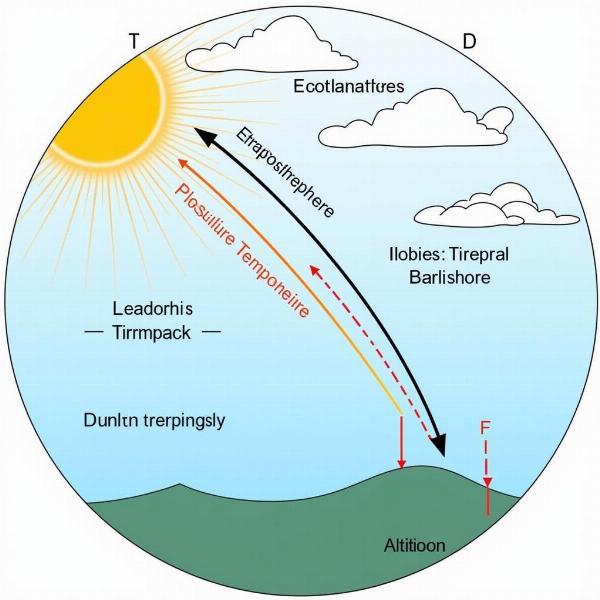The troposphere, where we live and breathe, is often a mystery despite its proximity. If you’re looking for the Hindi meaning of “troposphere,” you’ve come to the right place. This article will explore the troposphere’s definition, its importance, and its Hindi equivalent, along with related meteorological terms and cultural contexts. Understanding the Hindi term for this crucial atmospheric layer can deepen your connection with both science and Indian culture.
Understanding the Troposphere
The troposphere is the lowest layer of Earth’s atmosphere, extending from the surface up to an average height of about 10 kilometers (6.2 miles), although this height varies with latitude and season. It’s characterized by decreasing temperature with altitude. Almost all weather phenomena occur within this layer, making it vital for life on Earth. From the gentle breezes to the fiercest storms, the troposphere is where atmospheric dynamics unfold. But what do we call this critical layer in Hindi?
The Hindi word for troposphere is क्षोभमंडल (kshobhmandal). This term is derived from two Sanskrit words: “kshobh” (क्षोभ), meaning turbulence or disturbance, and “mandal” (मंडल), meaning sphere or zone. Therefore, kshobhmandal literally translates to “the sphere of turbulence,” accurately reflecting the dynamic nature of this atmospheric layer.
 Diagram of Kshobhmandal
Diagram of Kshobhmandal
The Importance of Kshobhmandal (Troposphere)
Kshobhmandal plays a crucial role in regulating Earth’s temperature and climate. The greenhouse effect, where certain gases trap heat within the atmosphere, primarily occurs within this layer. This effect, while essential for maintaining a habitable temperature, can also be impacted by human activities, leading to climate change. Understanding kshobhmandal’s function is crucial for comprehending these complex environmental processes.
Water vapor, essential for all forms of life, is mostly concentrated in the troposphere. The water cycle, involving evaporation, condensation, and precipitation, unfolds within this layer. From the monsoon rains that nourish India’s agricultural lands to the formation of clouds that provide shade on a sunny day, the kshobhmandal’s influence is pervasive.
Meteorological Terms Related to Kshobhmandal
Understanding the Hindi term for troposphere also opens doors to a broader understanding of meteorological concepts in Hindi. Here are a few examples:
- Vayu Mandal (वायु मंडल): Atmosphere
- Jal Chakra (जल चक्र): Water cycle
- Varsha (वर्षा): Rainfall
- Badal (बादल): Cloud
- Taapman (तापमान): Temperature
Learning these terms can enrich your understanding of weather discussions and forecasts in Hindi.
Troposphere in Indian Cultural Context
While the scientific understanding of the troposphere is relatively modern, the concept of a layered sky exists in ancient Indian cosmology. Ancient texts often refer to different realms or “lokas” above the Earth, which, while not directly equivalent to the scientific layers of the atmosphere, reflect an awareness of the sky’s complex structure. This ancient wisdom, combined with modern scientific understanding, provides a richer and more nuanced perspective on our place in the universe.
Tropopause: The Boundary
The upper boundary of the troposphere is called the tropopause. This boundary acts as a lid, preventing significant mixing of air between the troposphere and the stratosphere above. In Hindi, the tropopause is known as क्षोभसीमा (kshobhasima), where “sima” means boundary or limit.
Conclusion
Understanding the Hindi meaning of troposphere – kshobhmandal – not only expands your vocabulary but also enhances your understanding of this vital atmospheric layer. By connecting scientific concepts with culturally relevant terms, we can deepen our appreciation for the natural world and its intricacies. From the weather patterns that shape our daily lives to the broader context of climate change, the troposphere, or kshobhmandal, plays a central role in our existence.
FAQ
-
What is the Hindi word for troposphere? The Hindi word for troposphere is क्षोभमंडल (kshobhmandal).
-
Why is the troposphere important? The troposphere is important because it’s the layer where weather occurs and it regulates Earth’s temperature.
-
What is the meaning of kshobhmandal? Kshobhmandal means “the sphere of turbulence,” reflecting the dynamic nature of the troposphere.
-
What is the upper boundary of the troposphere called in Hindi? The upper boundary of the troposphere is called क्षोभसीमा (kshobhasima) in Hindi.
-
Where can I learn more about meteorological terms in Hindi? You can explore online resources and Hindi scientific publications to learn more about meteorological terms.
-
How does the troposphere relate to Indian culture? While not directly equivalent to scientific understanding, ancient Indian cosmology recognized a layered structure of the sky, reflecting an awareness of its complexity.
-
What is the role of water vapor in the troposphere? Water vapor in the troposphere is essential for the water cycle and weather phenomena.
Meaning-Hindi.in is your premier resource for Hindi translations, offering accurate and culturally sensitive language services. We specialize in business, legal, technical, website, educational, and specialized translations, including expedited services. Our expertise ensures that your message is conveyed effectively and respectfully across linguistic and cultural boundaries. Need help with your next translation project? Contact us today! Email: [email protected], Phone: +91 11-4502-7584. Meaning-Hindi.in is your trusted partner for all your Hindi translation needs.